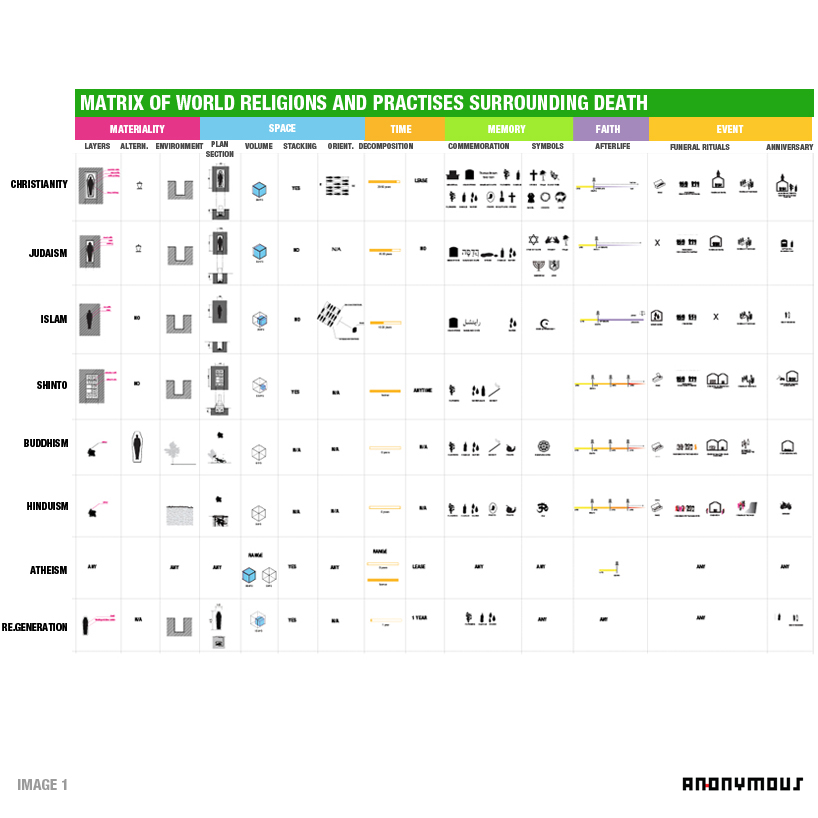
re generation by Nowak from usa
designer's own words:
INTRODUCTION
Death has fascinated us for centuries. Our curiosity towards death has captured our imagination, and has kept some of us to speculate, and led others to believe. Until the past century death was a spectacle: from the mystery of dying in bed, to the great ceremonies in cathedrals, processions, and burials in graveyards. “Beautiful deaths” were high points in the collective memory. Death was at the center of life, just as cemeteries were in the center of towns. They held festivals and markets. They were filled with crowds who seemed to be concerned with everything but death. Today cemeteries and crematories are pushed outside of our cities and are largely unattended. They are used merely as a space for disposal of bodies, and therefore, have turned the space they occupy into the function they hold within: a dead space.
How can we bring a life back to “death”?
FAITH
For many, burial is a show of respect for the dead. And when one believes in an afterlife, burial is as a necessary step to reach that. But the growing secularism and disbelief have changed the way we perceive death or treat bodily remains.
How do we commemorate dead in the absence of faith?
MATERIALITY
Human body consists of flesh, muscles, nerves, skin, bones and internal organs. As soon as the heart stops pumping blood, the tissues and cells are deprived of oxygen and begin to die and decompose. Decomposition happens rapidly, and is in fact, well under way by the time of burial or cremation. The exact rate of decomposition depends on environmental conditions. Decomposition in the air is twice as fast as that under water, and four times as fast as under ground. Because of that, corpses are preserved longer when buried deeper.
So how does the decomposition work? The body undergoes its own breakdown under the action of enzymes. The decomposing tissues release green substances and gas, which make the skin appear green and blistered. The front of the body swells, and fluids from the lungs come out of the mouth and nostrils. Hair, nails and teeth become detached within a few weeks, and after a month or so the tissues become liquefied and the main body cavity bursts open. This unpleasant sight is added to a terrible smell, as gases such as hydrogen sulphide and methane are released. So while burying a body conceals that sight and smell, the body decomposes at a much slower rate the deeper it is inside the ground.
How can we accelerate decomposition without jeopardizing the hygiene of our living environment?
SPACE
Because the body consists of material, therefore it occupies space. An average human body occupies 2.8 cubic feet of space. An average cremated human body occupies 0.1 cubic feet of space, which is about 28 times less. This explains the increase in cremation in the western world. With the growth of population, cities have struggled to find space for the dead. New York City, for instance, has a death rate of 148 persons per day. If we start burying people in Central Park, the park will be filled in just about a year! And it will only take about 16 years for the dead to take over the entire island of Manhattan.
How can we continually house the dead in our cities in the most efficient way?
TIME
Time is an unquestionable element of death. Although material decomposition of the body lasts a certain amount of time, the memory of the dead stays as long as the living lives or remember. People can usually remember family members up to 3 generations back. So even the real commemorative aspect of a burial space functions only about 50 years. Some countries such as France and Sweden have laws regulating reuse of graves after twenty-five years. In the United States graves are "leased" usually for up to 100 years. But in most cases, they occupy a space for an indefinite period of time.
How can we create a “permanent place” for the dead without taking a permanent space?
MEMORY
People commemorate the dead differently: some with displaying of the deceased’s identity. The commemoration takes various forms: from building an impressive memorial, through erecting head stones with inscription of names, to the use of sculptures, symbols and imagery. Oftentimes, the loss of the inscription is the loss of identity and meaning. After the funeral, the dead is left alone until a year after when people usually gather again to commemorate the dead. One-year anniversary is a critical moment, and a common ritual in almost every culture.
With the development of technology and the change of our lifestyle, how can we commemorate the dead today?
PROPOSAL
There are a number of concerns with the existing burial practices: the burial ground takes too much space. And, because of lack of oxygen the body doesn’t really decompose, but it rots, therefore contaminating the soil with toxins from the body. Burial ground requires special sewage and drainage system. And although cremation does not pose the same problems, it too has its inefficiencies. An average human body requires an energy equal to 23 liters of fuel oil, and half a kilo of activated carbon to be cremated. Besides carbon, there are flue gasses and mercury released into the atmosphere. In fact, 30% of the mercury in our air comes from crematories. The current burial methods do not present themselves as a sustainable practice. So what are alternative burial methods?
A few years ago, Susanne Masak, a Swedish marine biologist developed an ecological process, called “Promessa” that composites the body into soil. In a first step, the body is frozen with liquid nitrogen and vibrated so that it breaks into smaller pieces. Next, the pieces are transported to a freeze dryer under a vacuum. The vacuum removes 70% of the water from the body. Finally, the pieces of mercury and other metals are removed through the vacuum.
Our goal is to take advantage of Promessa’s freezing method within a new ecological system of burial called RE.GENERATION. In this method, once the body is processed, it is placed in a biodegradable coffin and buried in a shallow topsoil grave where there is more oxygen. The body converts fully into the soil within less than a year, and because decomposition happens quite rapidly, the chemical process itself can be used to harness energy though the use of microbial fuel cell technology. Microbial fuel cell (MFC) technology is a method of renewable energy where organic matter is converted into electricity through the use of bacteria. Normally, bacteria would use the energy produced to feed its own metabolism, but through that technology, the energy is instead harnessed in form of electricity.
The electricity generated through this process could be used to illuminate the name and identity of the person buried. Once the process of decomposition starts the name will start to illuminate; throughout the year the light brightens, and towards the end of the year the light fades out. It would sign of the full decomposition and absence of bodily remains. By this time all the remains have turned into soil, and the space is ready to be re-used by another body. The illumination of light is in chorus with the mourning and grief for the dead, and when it ends around the time of the first anniversary, it marks a new commemorative moment for a gathering and a final farewell to the deceased. Although then space is used by another body, the name and identity leaves a permanent mark on the tombstone. The shining name amongst the rest is the person buried last whose body is still present and in the process of decomposition.
The burial system’s relationship to the ground can also create different configuration and new spatial typologies around the tomb, which could inform a new landscape of the cemetery.
Unlike burial or cremation, RE.GENERATION does not pollute the ground, the water, or the air and does not require special drainage or sewage system. Once a certain number of burial units are built, the cemetery would be in no need for expansion as the spaces would constantly be re-used. But above all, this system redefines not only the practice burial, but also the sequence of grief, mourning, and commemoration through an advanced mechanism that draws the energy from decomposition and brings a life to the space above.
Matrix of religious practices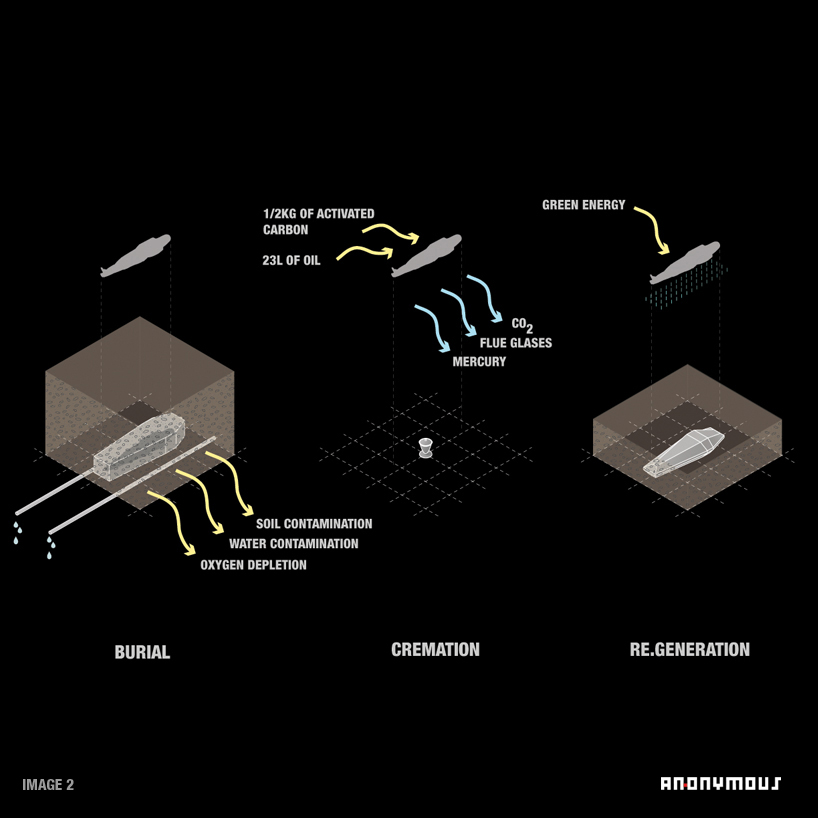 Burial methods comparison [jwplayer config=”mplayer” width=”818px” height=”600px” file=”https://static.designboom.com/wp-content/compsub/372946/2013-04-17/video_1_1366165709_a58aa9407c79467ad7d69826766ebc22.mp4″ html5_file=”https://static.designboom.com/wp-content/compsub/372946/2013-04-17/video_1_1366165709_a58aa9407c79467ad7d69826766ebc22.mp4″ download_file=”https://static.designboom.com/wp-content/compsub/372946/2013-04-17/video_1_1366165709_a58aa9407c79467ad7d69826766ebc22.mp4″]video
Burial methods comparison [jwplayer config=”mplayer” width=”818px” height=”600px” file=”https://static.designboom.com/wp-content/compsub/372946/2013-04-17/video_1_1366165709_a58aa9407c79467ad7d69826766ebc22.mp4″ html5_file=”https://static.designboom.com/wp-content/compsub/372946/2013-04-17/video_1_1366165709_a58aa9407c79467ad7d69826766ebc22.mp4″ download_file=”https://static.designboom.com/wp-content/compsub/372946/2013-04-17/video_1_1366165709_a58aa9407c79467ad7d69826766ebc22.mp4″]video
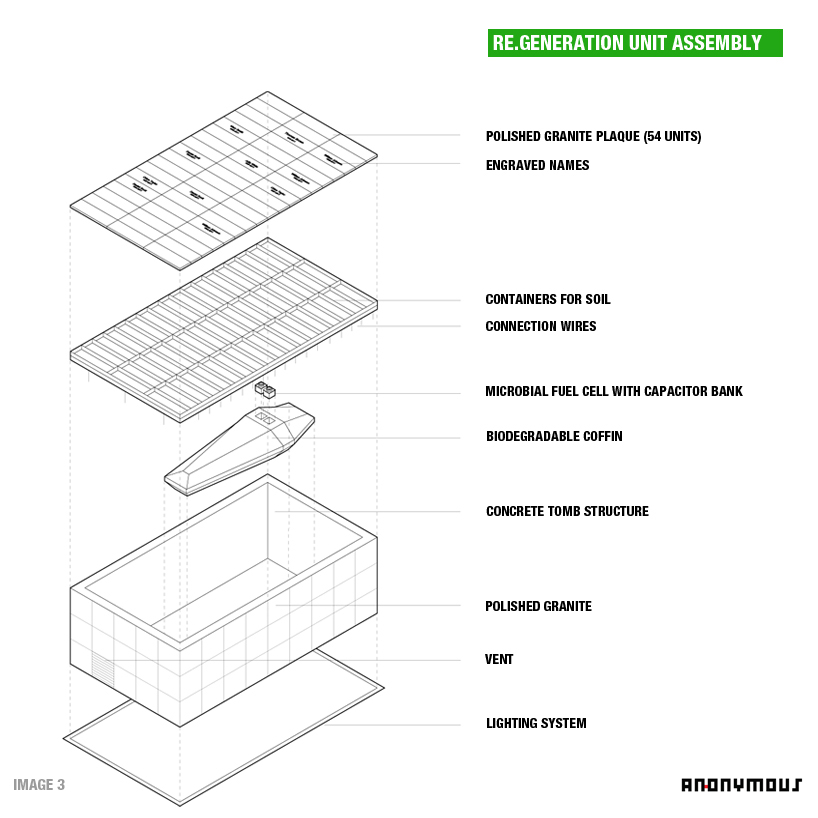 RE.GENERATION unit
RE.GENERATION unit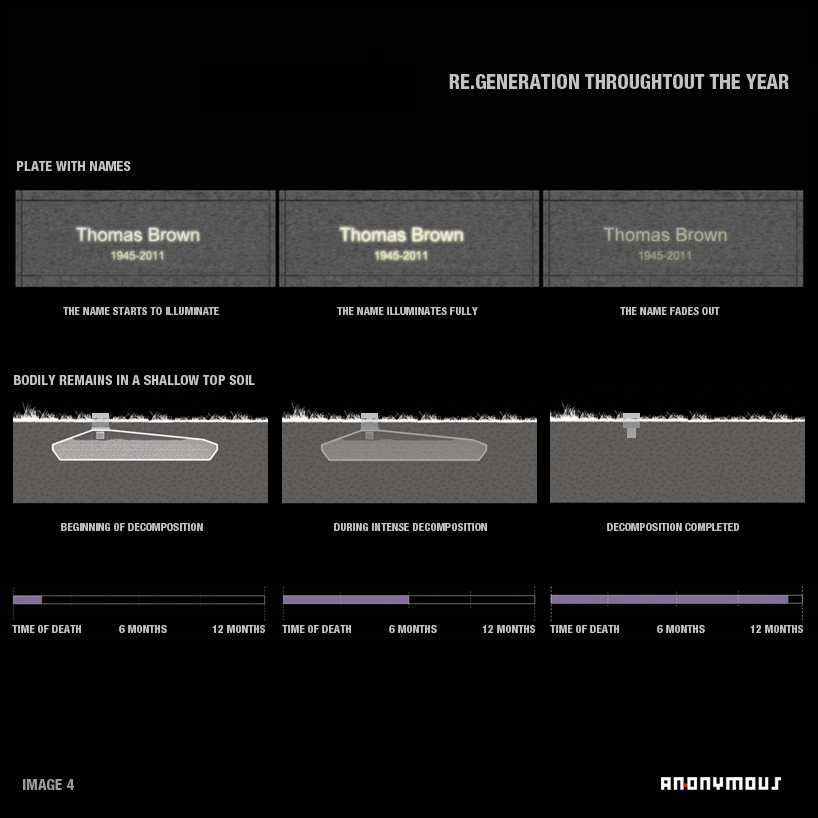 RE.GENERATION throughout the year
RE.GENERATION throughout the year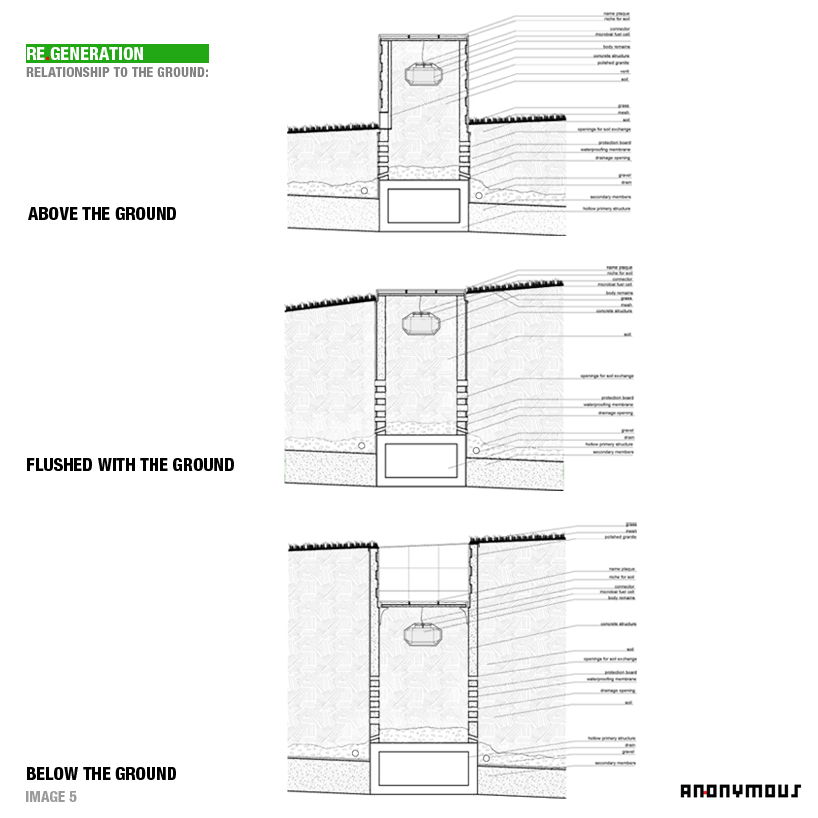 Ground relationships[jwplayer config=”mplayer” width=”818px” height=”600px” file=”https://static.designboom.com/wp-content/compsub/372946/2013-04-17/video_2_1366165710_83670305311ad2946fced27d25dfd598.mp4″ html5_file=”https://static.designboom.com/wp-content/compsub/372946/2013-04-17/video_2_1366165710_83670305311ad2946fced27d25dfd598.mp4″ download_file=”https://static.designboom.com/wp-content/compsub/372946/2013-04-17/video_2_1366165710_83670305311ad2946fced27d25dfd598.mp4″]video
Ground relationships[jwplayer config=”mplayer” width=”818px” height=”600px” file=”https://static.designboom.com/wp-content/compsub/372946/2013-04-17/video_2_1366165710_83670305311ad2946fced27d25dfd598.mp4″ html5_file=”https://static.designboom.com/wp-content/compsub/372946/2013-04-17/video_2_1366165710_83670305311ad2946fced27d25dfd598.mp4″ download_file=”https://static.designboom.com/wp-content/compsub/372946/2013-04-17/video_2_1366165710_83670305311ad2946fced27d25dfd598.mp4″]video
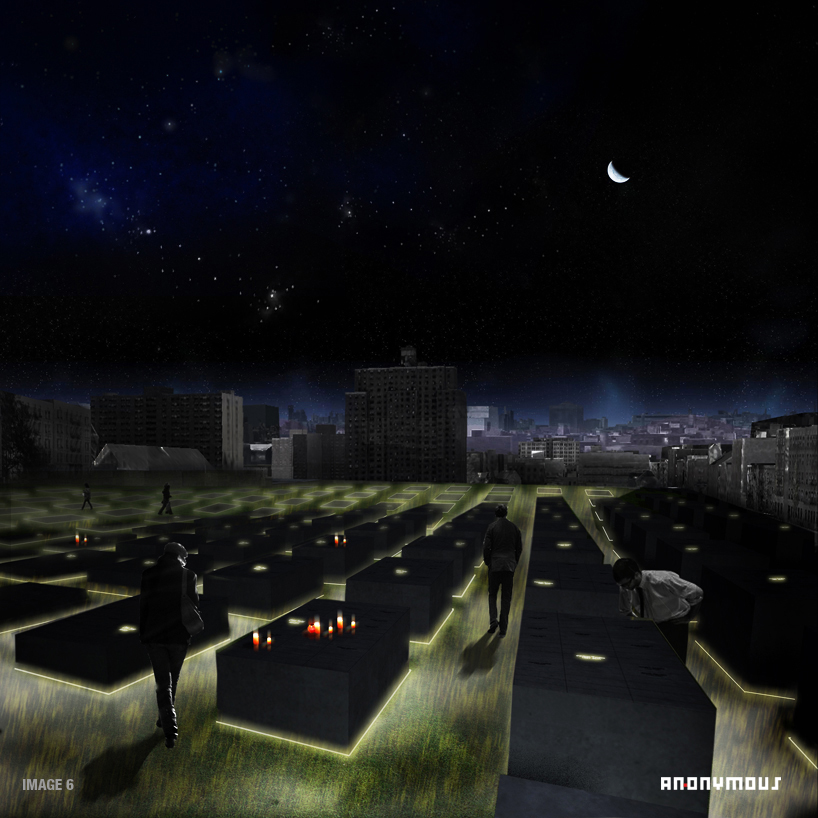 RE.GENERATION space at night
RE.GENERATION space at night